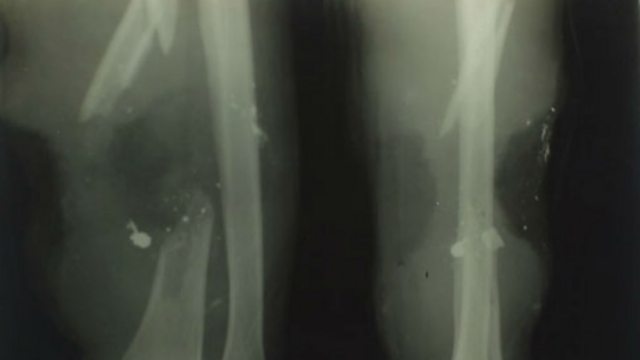Pembury, Tunbridge Wells: Cutting Edge X-Ray Technology
Century old X-rays demonstrate pioneering treatment of WW1 casualties
Private Hori Woolgan Jarvis of the 11th Royal West Kent Regiment had his arm shattered by a German sniper’s bullet on 14 June 1917. Many wounded soldiers with such severe injuries and shrapnel would have lost limbs through amputation but Private Jarvis was fortunate to be treated at Tunbridge Wells General Hospital.
Here he was treated by the most cutting edge X-ray department outside London. Not only did X-ray make it possible for him to have a bone graft but the success of the treatment enabled him to return to his pre-war occupation as a baker and pastry chef.
Sara Parker interviewed his daughter-in-law who found Private Jarvis’s original X-ray plates in the garage when her husband died. She remembers how her father-in-law had been well enough to make the wedding cake for their wedding.
Sara was also shown the fragile glass X-ray plates which have been donated to Tunbridge Wells Museum and spoke to hospital archivist John Weeks about the important role of the Salomon family as benefactors. Sir David Lionel Salomon developed the X-ray department in 1915, in memory of his son, Captain David Reginald Salomons who was killed when his troop ship the HMS Hythe sunk off Gallipoli.
Location: Tunbridge Wells Hospital, Kent TN2 4QJ
Image: Private Hori Jarvis’ X-ray, courtesy of Liz Douglas from Tunbridge Wells Museum
Duration:
This clip is from
Featured in...
![]()
�������� Radio Kent—World War One At ��������
Places in Kent that tell a story of World War One
More clips from World War One At ��������
-
![]()
The loss of HMY Iolaire
Duration: 18:52
-
![]()
Scotland, Slamannan and the Argylls
Duration: 07:55
-
![]()
Scotland Museum of Edinburgh mourning dress
Duration: 06:17
-
![]()
Scotland Montrose 'GI Brides'
Duration: 06:41







